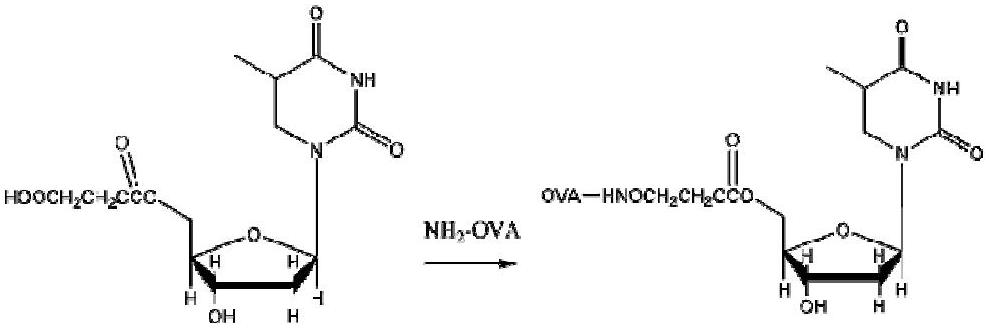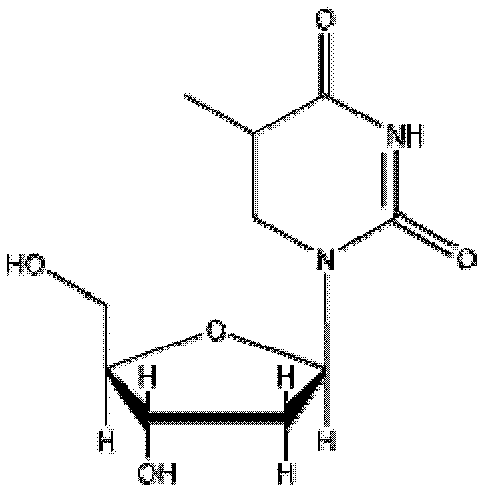DiHT-type universal hapten and artificial antigen of food radiation marker, and preparation method and application thereof
A hapten and antigen technology, which is applied in the field of food irradiation marker DiHT general hapten, artificial antigen and its preparation, to achieve the effect of less side reactions and easy operation
- Summary
- Abstract
- Description
- Claims
- Application Information
AI Technical Summary
Problems solved by technology
Method used
Image
Examples
Embodiment 1
[0057] Example 1. Hapten preparation and identification
[0058] Weigh 5 mg of DiHT and 16.4 mg of succinic anhydride, and dissolve them in 5 mL of anhydrous pyridine. Heated at 60°C, stirred, and refluxed for 10h. After the reaction, add 10 mL of dichloromethane to the solution, collect the lower layer mixture, then wash 3 times with 10 mL of 5% (v / v) hydrochloric acid, discard the dichloromethane layer, dissolve the residue with 10 mL of ether, and wash with 10 mL of deionized Washed with water three times, the ether layer was dried over anhydrous magnesium sulfate, vacuum filtered, purified by silica gel column chromatography, and the ether was volatilized to obtain an oily substance. Adopt thin-layer chromatography (TLC) to follow up in reaction process, and to product nuclear magnetic resonance collection of books ( 1 H-NMR) for characterization, see the process figure 2 .
Embodiment 2
[0059] Synthesis of embodiment 2.DiHT artificial antigen
[0060] The hapten DiHT was coupled to carrier proteins BSA and OVA by mixed anhydride method and activated ester method, respectively.
[0061] (1) Preparation of artificial antigen DiHT-COOH-BSA method by mixing anhydrides
[0062] Weigh 6.68 mg of DiHT-COOH powder and dissolve it in 3 mL of anhydrous DMF, oscillate and stir, add 40 μL of tri-n-butylamine, add 40 μL of isobutyl chloroformate under ice-cooling, stir and react at 4°C for 1 hour, and then warm to room temperature for 1 hour. It is called reaction solution 1. Weigh 120mg of BSA dissolved in 12mL of 0.2mol / L borate buffer (pH=8.7), this is solution 2. The reaction solution 1 was added dropwise to the solution 2 under stirring at room temperature, and stirred overnight at 15°C. The mixed solution was stirred and dialyzed with distilled water at 4°C, and the water was changed once every 4 hours for a total of 6 times until the hapten UV absorption was not...
Embodiment 3
[0065] Example 3. Identification of artificial antigens
[0066] The identification of artificial antigen is mainly carried out by two methods of UV ultraviolet scanning and SDS-PAGE gel electrophoresis.
[0067] (1) UV scanning identification
[0068] Dilute the artificial antigen and BSA to an appropriate concentration, scan in the wavelength range of 190-400nm, and obtain the ultraviolet spectrum of the hapten.
[0069] (2) Identification by SDS-PAGE gel electrophoresis
[0070] Select the concentration of the stacking gel to be 5%, the concentration of the separating gel to be 12%, the voltage of the stacking gel to be 120v, and the voltage of the separating gel to be 60v. Photographic observation.
PUM
 Login to View More
Login to View More Abstract
Description
Claims
Application Information
 Login to View More
Login to View More - R&D
- Intellectual Property
- Life Sciences
- Materials
- Tech Scout
- Unparalleled Data Quality
- Higher Quality Content
- 60% Fewer Hallucinations
Browse by: Latest US Patents, China's latest patents, Technical Efficacy Thesaurus, Application Domain, Technology Topic, Popular Technical Reports.
© 2025 PatSnap. All rights reserved.Legal|Privacy policy|Modern Slavery Act Transparency Statement|Sitemap|About US| Contact US: help@patsnap.com



